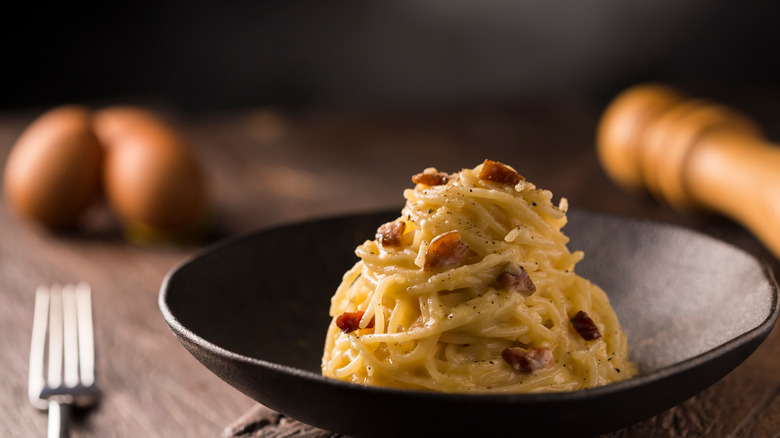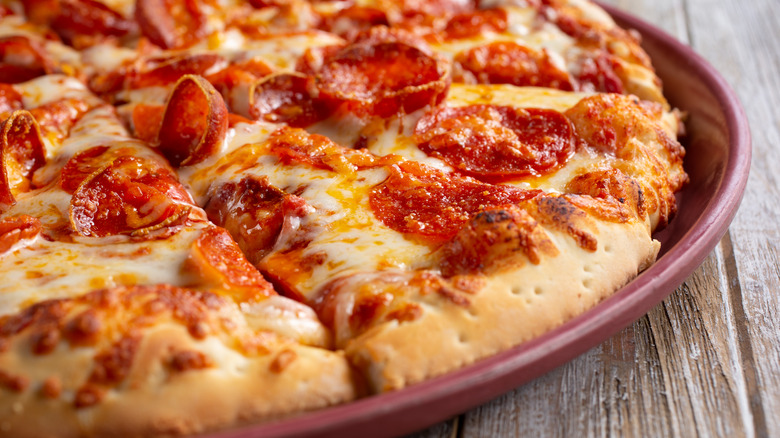The Origin Story Of Carbonara Just Got A Whole Lot More Interesting
Of all the cuisines in the world, it's quite possible Italian food is the most distinctive and widely beloved. Every time one of those cuisine ranking posts pops up on social media, the presence of Italian food at or near the top of the list is one of the few things about which nobody seems to have a complaint. It's a cuisine known for its distinctive dishes, such as pasta primavera, lasagna, pizza, and pasta carbonara.
Pasta carbonara is one of those deceptively simple yet intricately flavored dishes, starting with a long pasta (spaghetti, fettuccine, linguine, or similar) as a base and containing cured pork (typically pancetta, guanciale, or bacon), a hard cheese (Pecorino Romano is the most common, but you can use Parmigiano Reggiano), and black pepper. But the key ingredient is eggs, which gets mixed with the cheese and pepper and then combined with the pasta and meat (away from direct heat so it doesn't turn into scrambled eggs) to create a distinctive sauce.
It all comes together into one of the most classic Italian dishes. But there's the rub. Because if multiple Italian food historians are to be believed, pasta carbonara might not be entirely Italian.
So, where does pasta carbonara come from?
There's no denying that pasta carbonara originated in Italy — there's just a question of the how and when. Though we think of it as one of the traditional Italian dishes, its creation is relatively recent, dating to some time in the mid-20th century. As far as the "how," there's a strong possibility it was created using American food rations for American customers.
It would be a lot easier for Italians to dismiss this if the sources for these claims weren't coming from Italian food historians. Alberto Grandi and Luca Cesari are both born-and-bred Italians who study the history of their native cuisine, and they've separately come to the same conclusion. A lot of aspects of Italian food were only created thanks to Americans. In the case of pasta carbonara, it's Cesari's research that's most relevant here, as it's his belief the dish was created in Rome late in World War II for British and American officers by an Italian chef named Renato Gualandi, using entirely American ration ingredients. The dish didn't even appear in an Italian media source until the mid-1950s.
So does that mean pasta carbonara isn't Italian? Well, maybe not entirely, but regardless, Italians are not happy about having to share credit for it. The Italian National Confederation of Direct Farmers (the "Colderetti") responded to Grandi's claims in particular, saying they "trivialized" Italian cuisine (via La Repubblica). Italian opinions about food are, unsurprisingly, quite strong.
There are a lot of Italian dishes that don't owe their origins to Italy
Despite what Italians might think, Italian food, at least as it's known in America, has a long history of dishes that were wholly created by Italian-Americans. The best-known example is probably spaghetti and meatballs, which is as American a dish as exists. Chicken parmesan is another one. These aren't under dispute, but there's a much bigger dish that is.
It's when historians get to pizza that things start to get really dicey. It's not in dispute that the precursor to pizza was created in Naples in the 18th century — the Neapolitan style of pizza twirling was even granted UNESCO heritage status in 2017 — and in Italy, that's still "pizza." But the story is a little more complex than that, for a variety of reasons.
First, Neapolitan pizza looks nothing like what Americans think of as pizza. It doesn't come in slices, and it's basically an oversized Ritz cracker with some toppings on it. The Italian version doesn't even traditionally feature tomato sauce, and the idea of adding pepperoni was an entirely American invention. While pizza was created in Italy, the type of pizza Americans know and love was established in the United States.


